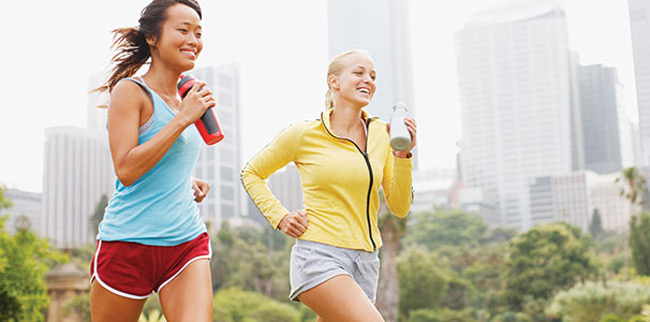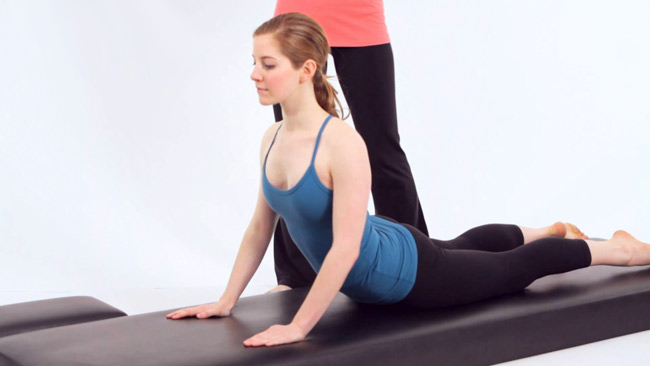
Runners need to follow a well-balanced training regimen that might include yoga, cycling and swimming etc. Pilates workout can also offer runners multiple benefits. Pilates helps one to identify areas of weakness that can inhibit running posture and learn muscular cues to help fire the muscles surrounding the diaphragm, spine, ribs and hips in such a way to maintain better posture through the gait cycle.
Benefits of Pilates for Runners
- Stronger Core: One may think you run mainly with your legs, but you also use your psoas muscle (lower abdomen). Having a strong core is key, especially when running uphill, so your lower back doesn’t take over. Doing Pilates, involves the core muscles.
- Enhanced Hip Strength: Stronger hips with increased flexibility, allows more fluid movements when running. Legs can kick back further and help stride improvement.
- Lesser stress on bones or joints: Body asymmetries develop because of poor body mechanics, causing certain muscles to become overused (a common trait in runners), while others become underused. This can result in a variety of ailments from lower back pain to hip bursitis to arterior knee problems.
Pilate Exercises
Swan
Utilize all your leg muscles and keep a healthy stride with this chest-opening move:

- Lying on your belly, hands in front of the shoulders, pull the belly off the floor and start to lengthen the upper body away from the mat, starting with the crown of the head reaching out and then up.
- Draw the shoulder blades close to the spine to open the chest and to stretch the entire front of the body from the crown of the head to the fronts of the legs.
- When you become more comfortable with the exercise, you can add in a rock forward, which deeply challenges all of the back body muscles from feet to shoulders to maintain the deep control while stretching the front of the body.
- Repeat five times.
Leg Pull
Open the chest and strengthen the back and arms to achieve a more upright posture.
- From a seated position, stretch hands behind hips with fingers facing forward. Lift hips off mat to create a straight line from heels to shoulders. Legs are turned out slightly, and inner thighs are touching.
- Press the hands into the floor so that arm and upper back muscles are engaged. Press into the outer edge of the right foot, and stretch the left leg as high as possible without moving anything else.
- Extend the leg up, and continue to reach it as high as possible. Attempt 10 higher lifts, and switch sides.
- Repeat four to five times on each side.
Side Kick Kneeling
This exercise challenges your core so it prepare you for uphills, downhills, or turns.
- From a kneeling position, tip yourself to the left and allow your left hand to securely land on the floor, directly under the shoulder.
- Extend your right leg to hip height, ensuring that the leg is parallel to the floor. Sweep the leg forward and back 10 times, up and down 10 times, and circle 10 times in each direction. This is one cycle.
- Repeat for three cycles. Switch legs, and repeat for three cycles on the other side.
Corkscrew
Strengthen your obliques, core, and legs, while stretching your hips away from your ribs:
- Lie on your back, and pull the knees into the chest. Reach the legs up to the ceiling, and tightly squeeze them together, focusing on connecting your inner thighs.
- Reach the legs over to the right, allowing the hips to lift away from the floor.
- Reach the legs back to center but still engaged, ensuring that the lower back remains on the floor.
- Reach the legs over to the left, grounding the shoulders and allowing the hips to move first, the rib cage if possible next. Pull the legs back up in toward the body. This counts as one rep.
- Repeat 10 times.
Rollover
Roll over and lengthen your waistline and torso while challenging and strengthening the back of your legs:
- Lie on your back, and pull the knees into the chest. Extend the legs out to a 45-degree angle, engaging the inner thighs and reaching the legs as far out as possible without arching the lower back.
- Press into the upper back, and stretch the legs long as you reach them up to the ceiling. Use your core to draw them in; don’t just bend at your hip flexors.
- Keeping length through the spine throughout the exercise and never compressing, draw the pubic bone toward the belly button to lift the hips away from the floor. The legs will reach behind the body and be parallel to the floor.
- Keep the legs strong and the spine stretching back into the floor. Slowly extend your legs back down to rest on the ground.
- Repeat 10 times.
For a runner, posture is one of the key ingredients to success. Pilates develops a strong core by supporting and strengthening the muscles of the torso, hips shoulders and pelvis. These can eventually lead to a huge positive difference in your posture, technique, balance and stability. It enables you to focus on where your head and neck are in relation to the spine and pelvis, on down through the legs and toes. This all adds up to more efficient movement and less chance of injury.